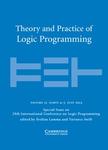版权所有:内蒙古大学图书馆 技术提供:维普资讯• 智图
内蒙古自治区呼和浩特市赛罕区大学西街235号 邮编: 010021

作者机构:SUNY Stony Brook Dept Comp Sci Stony Brook NY USA
出 版 物:《THEORY AND PRACTICE OF LOGIC PROGRAMMING》 (逻辑程序设计理论与实践)
年 卷 期:2013年第13卷第4-5期
页 面:705-719页
核心收录:
学科分类:08[工学] 0835[工学-软件工程] 0701[理学-数学] 0812[工学-计算机科学与技术(可授工学、理学学位)]
基 金:Vulcan, Inc NSF grant Direct For Computer & Info Scie & Enginr Division of Computing and Communication Foundations Funding Source: National Science Foundation
主 题:terminyzer termination and non-termination analysis logic programming
摘 要:A large body of work has been dedicated to termination analysis of logic programs but relatively little has been done to analyze non-termination. In our opinion, explaining non-termination is a much more important task because it can dramatically improve a user s ability to effectively debug large, complex logic programs without having to abide by punishing syntactic restrictions. Non-termination analysis examines program execution history when the program is suspected to not terminate and informs the programmer about the exact reasons for this behavior. In Liang and Kifer (2013), we studied the problem of non-termination in tabled logic engines with subgoal abstraction, such as XSB, and proposed a suite of algorithms for non-termination analysis, called Terminyzer. These algorithms analyze forest logging traces and output sequences of tabled subgoal calls that are the likely causes of non-terminating cycles. However, this feedback was hard to use in practice: the same subgoal could occur in multiple rule heads and in even more places in rule bodies, so Terminyzer left too much tedious, sometimes combinatorially large amount of work for the user to do manually. Here we propose a new suite of algorithms, Terminyzer(+), which closes this usability gap. Terminyzer+ can detect not only sequences of subgoals that cause non-termination, but, importantly, the exact rules where they occur and the rule sequences that get fired in a cyclic manner, thus causing non-termination. This makes Terminyzer(+) suitable as a back-end for user-friendly graphical interfaces on top of Terminyzer(+), which can greatly simplify the debugging process. Terminyzer(+) back-ends exist for the SILK system as well as for the open-source Flora-2 system. A graphical interface has been developed for SILK and is currently underway for Flora-2. We also report experimental studies, which confirm the effectiveness of Terminyzer(+) on a host of large real-world knowledge bases. All tests used in this pape